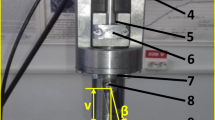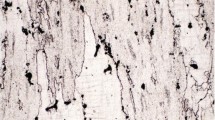Abstract
In a previous paper by Davidson, Eisenstadt and Reiner, it was noted that, as the diameter ratio of an open-end, thick-walled cylinder approached unity, the stress state due to internal pressure approaches that of uniaxial tension. It was, therefore, proposed that the fatigue life of a cyclically pressurized thick-walled cylinder might be predicted from the results of axialtension fatigue tests. In this paper, the results of the thick-walled-cylinder fatigue tests, reported in Ref. 2, extrapolated to a diameter ratio of unity, are compared with the results of axial-tension fatigue tests on the same material. The effect of oil in contact with the surface of the axial fatigue specimens and that of varying the cyclic speed from 1800 cpm to 200 cpm are investigated. Rotating beam fatigue test results for the same material are also reported.
The results of the axial-tension fatigue tests do not agree with the extrapolated thick-walled cylinder results in the range of fatigue lives from 104 to 106 cycles with the cylinder results showing the shorter lives. For less than 104 cycles, the results converge. No effect of cyclic speed or of oil in contact with the surface was found.
The results of the rotating-beam tests generally lie between the axial-tension and extrapolated cylinder results.
Similar content being viewed by others
Abbreviations
- W:
-
diameter ratio=outside diameter/inside diameter
- σ t :
-
tangential stress
- σ r :
-
radial stress
- UTS:
-
ultimate tensile strength
- N:
-
number of cycles to failure
- R:
-
stress ratio=minimum stress/maximum stress
References
Morrison, J. L. M., Crossland, B., andParry, J. S. C., “The Strength of Thick Cylinders Subjected to Repeated Internal Pressure,”Trans. ASME, Jnl. Engr. for Ind.,82,143–153 (1960).
Davidson, T. E., Eisenstadt, R., and Reiner, A. N., “Fatigue Characteristics of Open End. Thick Walled Cylinders Under Cyclic Internal Pressure,” Trans. ASME, Jnl. Basic Engr. (Dec. 1963).
Crossland, B., “Effect of Large Hydrostatic Pressure on the Torsional Fatigue Strength of an Alloy Steel,” Internat. Conf. on Fatigue of Metals, 138 (1956).
White, D. J., Crossland, B., andMorrison, J. L. M., “The Effect of Hydrostatic Pressure on the Direct-Stress Fatigue Strength of an Alloy Steel,”Mech. Engr. Sci.,1,39 (1959).
Sachs, G., andScheven, G., “Relation Between Direct-Stress and Bending Fatigue of High Strength Steels,”Proc. ASTM,57,667–681 (1957).
Finch, W. G., “A Study of Fatigue in Steels in the Finite Region of the S-N Curve,”Proc. ASTM,52,759–777 (1952).
Author information
Authors and Affiliations
Rights and permissions
About this article
Cite this article
Eisenstadt, R., Kendall, D.P. & Davidson, T.E. A comparison of results of axial-tension, rotating-beam and pressurized-cylinder fatigue tests. Experimental Mechanics 9, 250–254 (1969). https://doi.org/10.1007/BF02325156
Issue Date:
DOI: https://doi.org/10.1007/BF02325156




